Recruitment Bias and Unconscious Bias in Human Resource Management
VerifiedAdded on 2023/01/10
|9
|2247
|2
Report
AI Summary
This report delves into the critical issue of recruitment bias within human resource management, particularly focusing on the impact of unconscious biases. It explores various forms of bias, including those related to skin color, gender, age, and other factors, and examines how these biases can influence decisions throughout the recruitment process, from hiring to promotion. The report highlights the risks associated with unconscious bias, such as reduced workforce diversity and a negative business culture, and emphasizes the importance of a diverse workforce for innovation and legal compliance. It identifies several types of unconscious bias, including the beer test, availability heuristic, confirmation bias, endowment effect, groupthink, halo effect, negativity bias, and functional fixedness, providing detailed explanations and examples of each. Furthermore, the report outlines practical strategies for mitigating bias in the workplace, such as implementing interrupters, fostering open conversations about cognitive biases, re-evaluating the application process, and using structured recruitment processes. The conclusion underscores the importance of monitoring recruitment processes and ensuring they are free from bias to attract top talent and make fair hiring decisions. The report also includes a self-reflection section and a comprehensive list of references to support its findings.
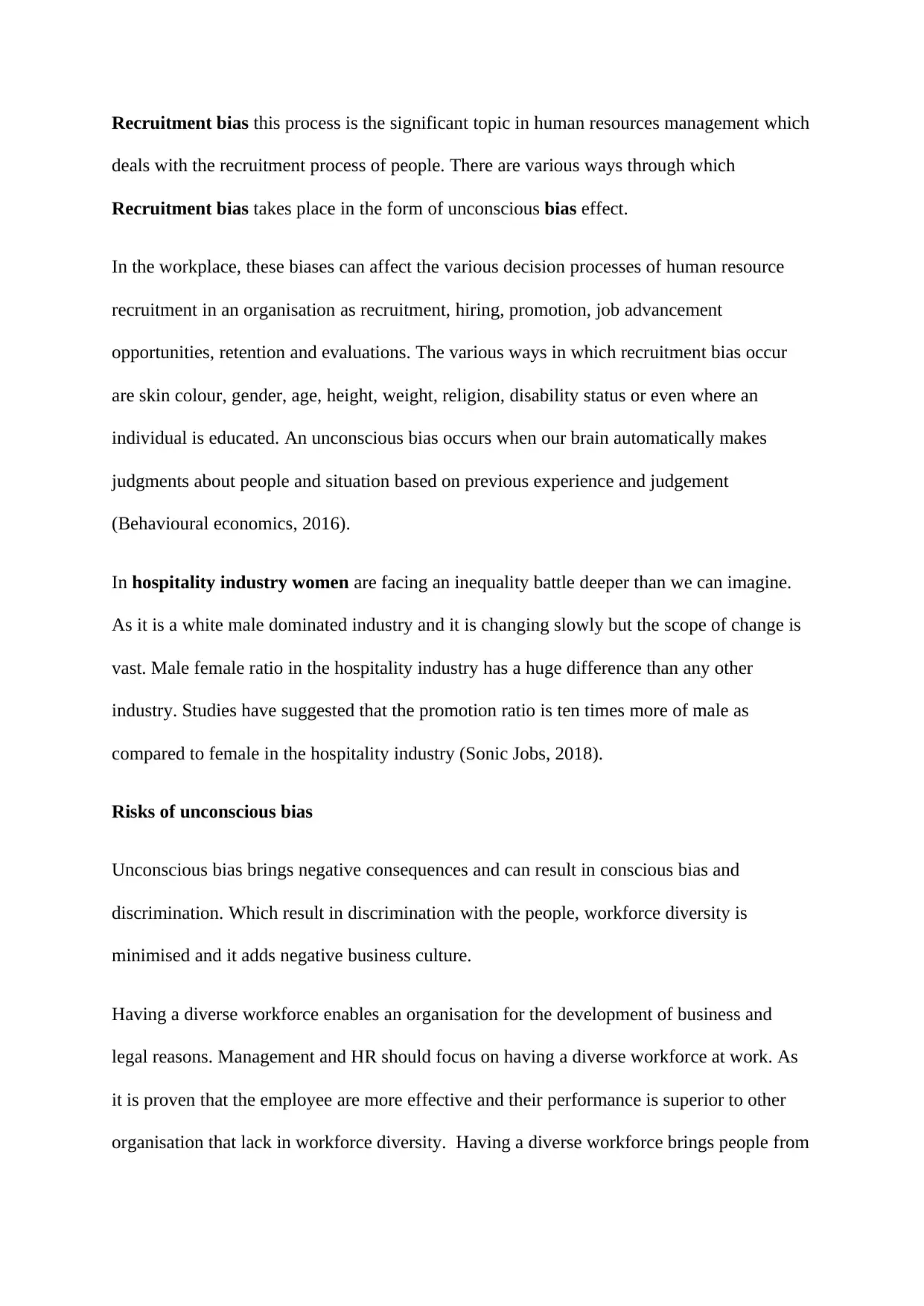
Recruitment bias this process is the significant topic in human resources management which
deals with the recruitment process of people. There are various ways through which
Recruitment bias takes place in the form of unconscious bias effect.
In the workplace, these biases can affect the various decision processes of human resource
recruitment in an organisation as recruitment, hiring, promotion, job advancement
opportunities, retention and evaluations. The various ways in which recruitment bias occur
are skin colour, gender, age, height, weight, religion, disability status or even where an
individual is educated. An unconscious bias occurs when our brain automatically makes
judgments about people and situation based on previous experience and judgement
(Behavioural economics, 2016).
In hospitality industry women are facing an inequality battle deeper than we can imagine.
As it is a white male dominated industry and it is changing slowly but the scope of change is
vast. Male female ratio in the hospitality industry has a huge difference than any other
industry. Studies have suggested that the promotion ratio is ten times more of male as
compared to female in the hospitality industry (Sonic Jobs, 2018).
Risks of unconscious bias
Unconscious bias brings negative consequences and can result in conscious bias and
discrimination. Which result in discrimination with the people, workforce diversity is
minimised and it adds negative business culture.
Having a diverse workforce enables an organisation for the development of business and
legal reasons. Management and HR should focus on having a diverse workforce at work. As
it is proven that the employee are more effective and their performance is superior to other
organisation that lack in workforce diversity. Having a diverse workforce brings people from
deals with the recruitment process of people. There are various ways through which
Recruitment bias takes place in the form of unconscious bias effect.
In the workplace, these biases can affect the various decision processes of human resource
recruitment in an organisation as recruitment, hiring, promotion, job advancement
opportunities, retention and evaluations. The various ways in which recruitment bias occur
are skin colour, gender, age, height, weight, religion, disability status or even where an
individual is educated. An unconscious bias occurs when our brain automatically makes
judgments about people and situation based on previous experience and judgement
(Behavioural economics, 2016).
In hospitality industry women are facing an inequality battle deeper than we can imagine.
As it is a white male dominated industry and it is changing slowly but the scope of change is
vast. Male female ratio in the hospitality industry has a huge difference than any other
industry. Studies have suggested that the promotion ratio is ten times more of male as
compared to female in the hospitality industry (Sonic Jobs, 2018).
Risks of unconscious bias
Unconscious bias brings negative consequences and can result in conscious bias and
discrimination. Which result in discrimination with the people, workforce diversity is
minimised and it adds negative business culture.
Having a diverse workforce enables an organisation for the development of business and
legal reasons. Management and HR should focus on having a diverse workforce at work. As
it is proven that the employee are more effective and their performance is superior to other
organisation that lack in workforce diversity. Having a diverse workforce brings people from
Paraphrase This Document
Need a fresh take? Get an instant paraphrase of this document with our AI Paraphraser

different ethnic backgrounds having a different experience. That brings innovation & opinion
to the organisation. (Carnes, M., Devine, P.G., Isaac, C., Manwell, B.L., Ford, C.E., Winston,
A.B……et al., 2012)
The organisation has a legal perspective which ensures that they should follow the
ombudsman guidelines to avoid discrimination at work place. Ombudsman theory states the
employer does discrimination during the recruitment process with the potential employee that
may lead to litigation (Devine, P.G., Forscher, S.P., Austin, A.J., Cox, W.T.L., 2012)
Types of unconscious bias
Various researches have conducted in the field of social psychology and behavioural
economics which reveals the kinds of bias done at the workplace by the human resource
department during the time of recruitment in an organisation. Explanations of the terms used
to describe the kind of biases are given in the text below (Australian Public Service
Commission, 2014)
Beer test
This is one of the most common recruitment decisions, and it evaluates people who are
likable and easy to work which result in bias take place as this aspect neglects the skills of
other potential employees who in physical appearance are not more attractive, that bards an
organisation to recruit talent to an organisation. It is a human tendency to like people similar
to them or to make them part of their group. This can lead to hiring an employee who just
meets the requirements of a job over a more qualified potential employee. This might result
in reducing the organisation growth due to lack of expertise. The beer test in general, reduces
diversity of the workforce in an organisation in becomes an obstacle in the path of
development of the organisation (Wright, 2014).
to the organisation. (Carnes, M., Devine, P.G., Isaac, C., Manwell, B.L., Ford, C.E., Winston,
A.B……et al., 2012)
The organisation has a legal perspective which ensures that they should follow the
ombudsman guidelines to avoid discrimination at work place. Ombudsman theory states the
employer does discrimination during the recruitment process with the potential employee that
may lead to litigation (Devine, P.G., Forscher, S.P., Austin, A.J., Cox, W.T.L., 2012)
Types of unconscious bias
Various researches have conducted in the field of social psychology and behavioural
economics which reveals the kinds of bias done at the workplace by the human resource
department during the time of recruitment in an organisation. Explanations of the terms used
to describe the kind of biases are given in the text below (Australian Public Service
Commission, 2014)
Beer test
This is one of the most common recruitment decisions, and it evaluates people who are
likable and easy to work which result in bias take place as this aspect neglects the skills of
other potential employees who in physical appearance are not more attractive, that bards an
organisation to recruit talent to an organisation. It is a human tendency to like people similar
to them or to make them part of their group. This can lead to hiring an employee who just
meets the requirements of a job over a more qualified potential employee. This might result
in reducing the organisation growth due to lack of expertise. The beer test in general, reduces
diversity of the workforce in an organisation in becomes an obstacle in the path of
development of the organisation (Wright, 2014).
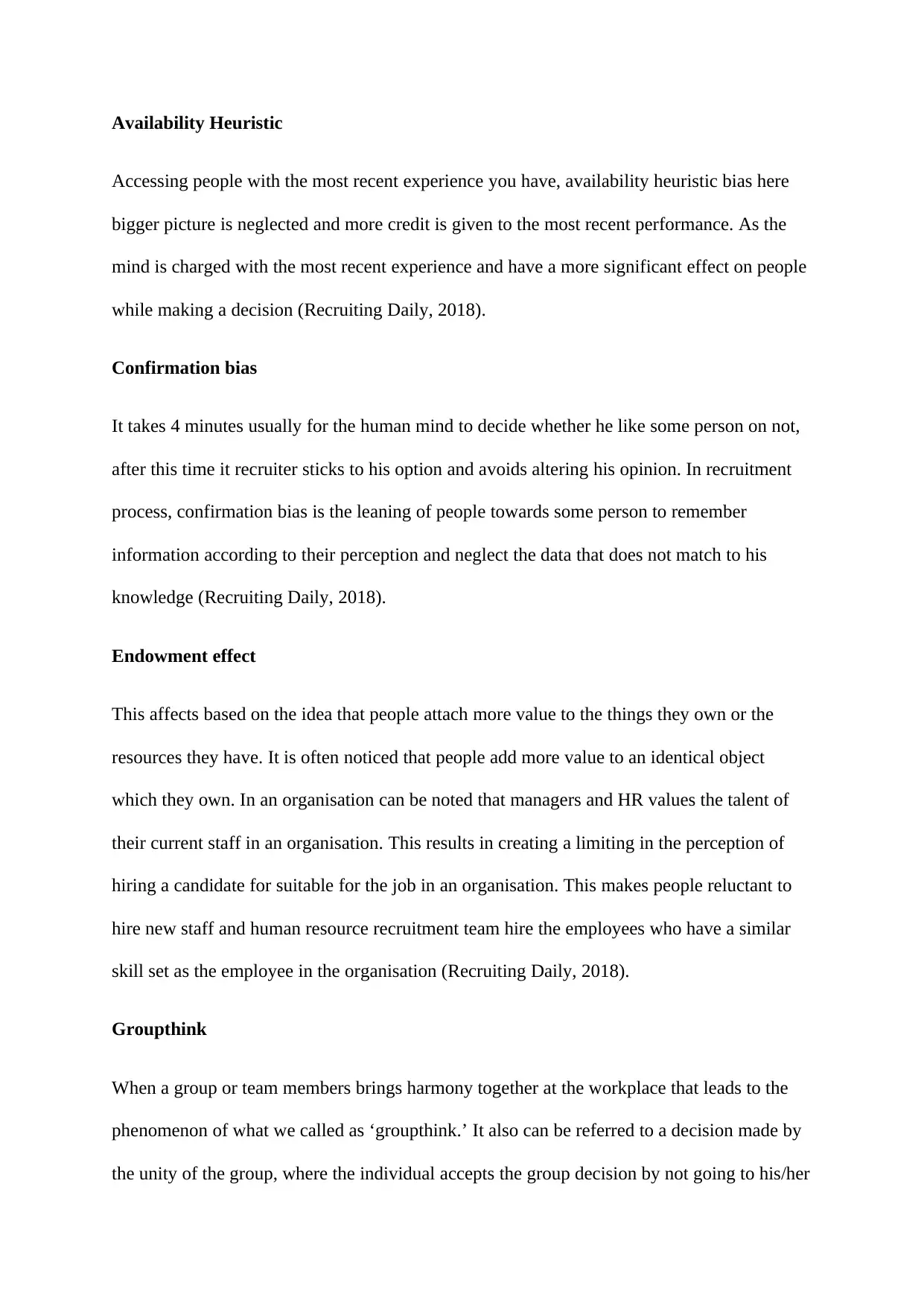
Availability Heuristic
Accessing people with the most recent experience you have, availability heuristic bias here
bigger picture is neglected and more credit is given to the most recent performance. As the
mind is charged with the most recent experience and have a more significant effect on people
while making a decision (Recruiting Daily, 2018).
Confirmation bias
It takes 4 minutes usually for the human mind to decide whether he like some person on not,
after this time it recruiter sticks to his option and avoids altering his opinion. In recruitment
process, confirmation bias is the leaning of people towards some person to remember
information according to their perception and neglect the data that does not match to his
knowledge (Recruiting Daily, 2018).
Endowment effect
This affects based on the idea that people attach more value to the things they own or the
resources they have. It is often noticed that people add more value to an identical object
which they own. In an organisation can be noted that managers and HR values the talent of
their current staff in an organisation. This results in creating a limiting in the perception of
hiring a candidate for suitable for the job in an organisation. This makes people reluctant to
hire new staff and human resource recruitment team hire the employees who have a similar
skill set as the employee in the organisation (Recruiting Daily, 2018).
Groupthink
When a group or team members brings harmony together at the workplace that leads to the
phenomenon of what we called as ‘groupthink.’ It also can be referred to a decision made by
the unity of the group, where the individual accepts the group decision by not going to his/her
Accessing people with the most recent experience you have, availability heuristic bias here
bigger picture is neglected and more credit is given to the most recent performance. As the
mind is charged with the most recent experience and have a more significant effect on people
while making a decision (Recruiting Daily, 2018).
Confirmation bias
It takes 4 minutes usually for the human mind to decide whether he like some person on not,
after this time it recruiter sticks to his option and avoids altering his opinion. In recruitment
process, confirmation bias is the leaning of people towards some person to remember
information according to their perception and neglect the data that does not match to his
knowledge (Recruiting Daily, 2018).
Endowment effect
This affects based on the idea that people attach more value to the things they own or the
resources they have. It is often noticed that people add more value to an identical object
which they own. In an organisation can be noted that managers and HR values the talent of
their current staff in an organisation. This results in creating a limiting in the perception of
hiring a candidate for suitable for the job in an organisation. This makes people reluctant to
hire new staff and human resource recruitment team hire the employees who have a similar
skill set as the employee in the organisation (Recruiting Daily, 2018).
Groupthink
When a group or team members brings harmony together at the workplace that leads to the
phenomenon of what we called as ‘groupthink.’ It also can be referred to a decision made by
the unity of the group, where the individual accepts the group decision by not going to his/her
⊘ This is a preview!⊘
Do you want full access?
Subscribe today to unlock all pages.

Trusted by 1+ million students worldwide
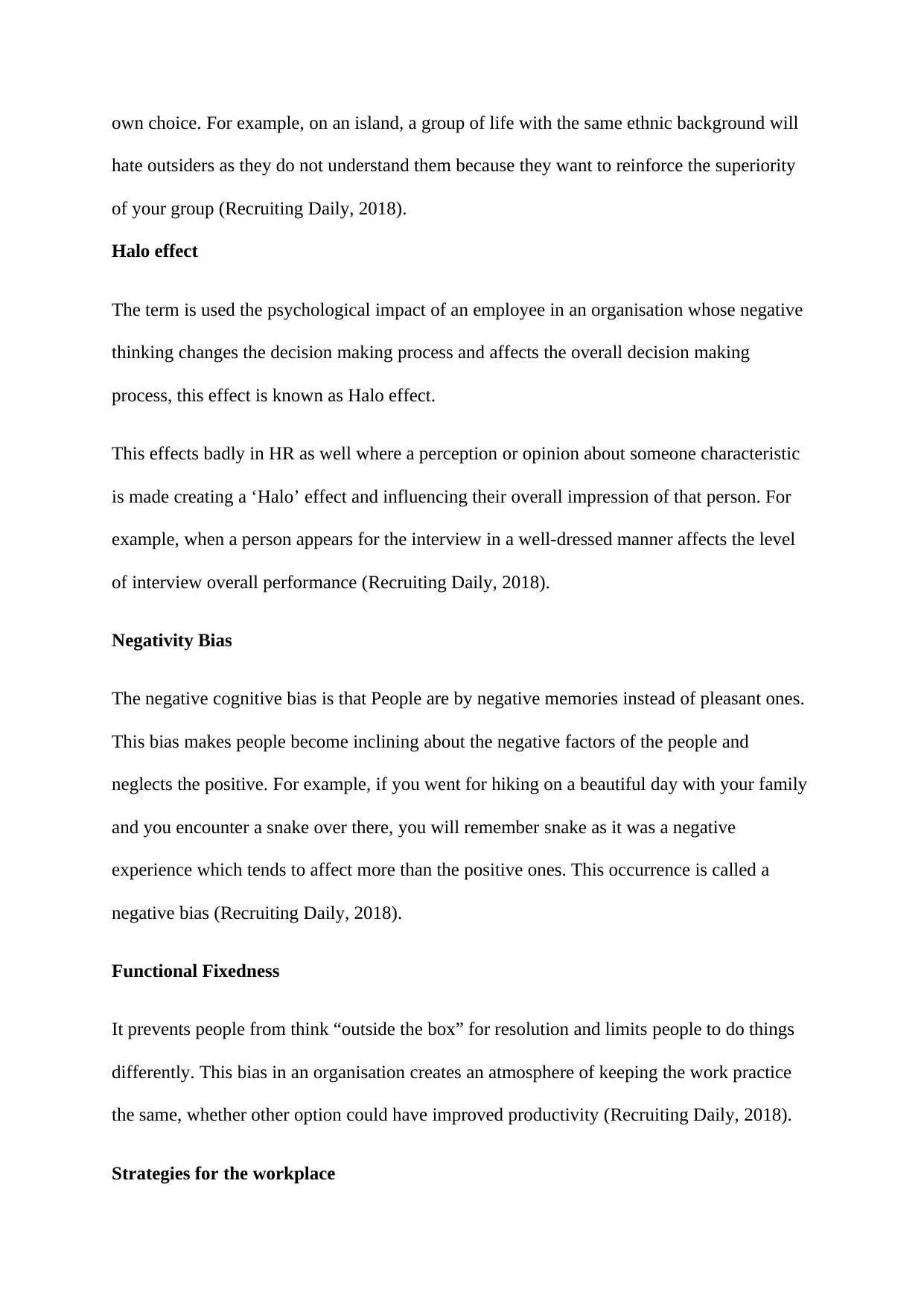
own choice. For example, on an island, a group of life with the same ethnic background will
hate outsiders as they do not understand them because they want to reinforce the superiority
of your group (Recruiting Daily, 2018).
Halo effect
The term is used the psychological impact of an employee in an organisation whose negative
thinking changes the decision making process and affects the overall decision making
process, this effect is known as Halo effect.
This effects badly in HR as well where a perception or opinion about someone characteristic
is made creating a ‘Halo’ effect and influencing their overall impression of that person. For
example, when a person appears for the interview in a well-dressed manner affects the level
of interview overall performance (Recruiting Daily, 2018).
Negativity Bias
The negative cognitive bias is that People are by negative memories instead of pleasant ones.
This bias makes people become inclining about the negative factors of the people and
neglects the positive. For example, if you went for hiking on a beautiful day with your family
and you encounter a snake over there, you will remember snake as it was a negative
experience which tends to affect more than the positive ones. This occurrence is called a
negative bias (Recruiting Daily, 2018).
Functional Fixedness
It prevents people from think “outside the box” for resolution and limits people to do things
differently. This bias in an organisation creates an atmosphere of keeping the work practice
the same, whether other option could have improved productivity (Recruiting Daily, 2018).
Strategies for the workplace
hate outsiders as they do not understand them because they want to reinforce the superiority
of your group (Recruiting Daily, 2018).
Halo effect
The term is used the psychological impact of an employee in an organisation whose negative
thinking changes the decision making process and affects the overall decision making
process, this effect is known as Halo effect.
This effects badly in HR as well where a perception or opinion about someone characteristic
is made creating a ‘Halo’ effect and influencing their overall impression of that person. For
example, when a person appears for the interview in a well-dressed manner affects the level
of interview overall performance (Recruiting Daily, 2018).
Negativity Bias
The negative cognitive bias is that People are by negative memories instead of pleasant ones.
This bias makes people become inclining about the negative factors of the people and
neglects the positive. For example, if you went for hiking on a beautiful day with your family
and you encounter a snake over there, you will remember snake as it was a negative
experience which tends to affect more than the positive ones. This occurrence is called a
negative bias (Recruiting Daily, 2018).
Functional Fixedness
It prevents people from think “outside the box” for resolution and limits people to do things
differently. This bias in an organisation creates an atmosphere of keeping the work practice
the same, whether other option could have improved productivity (Recruiting Daily, 2018).
Strategies for the workplace
Paraphrase This Document
Need a fresh take? Get an instant paraphrase of this document with our AI Paraphraser
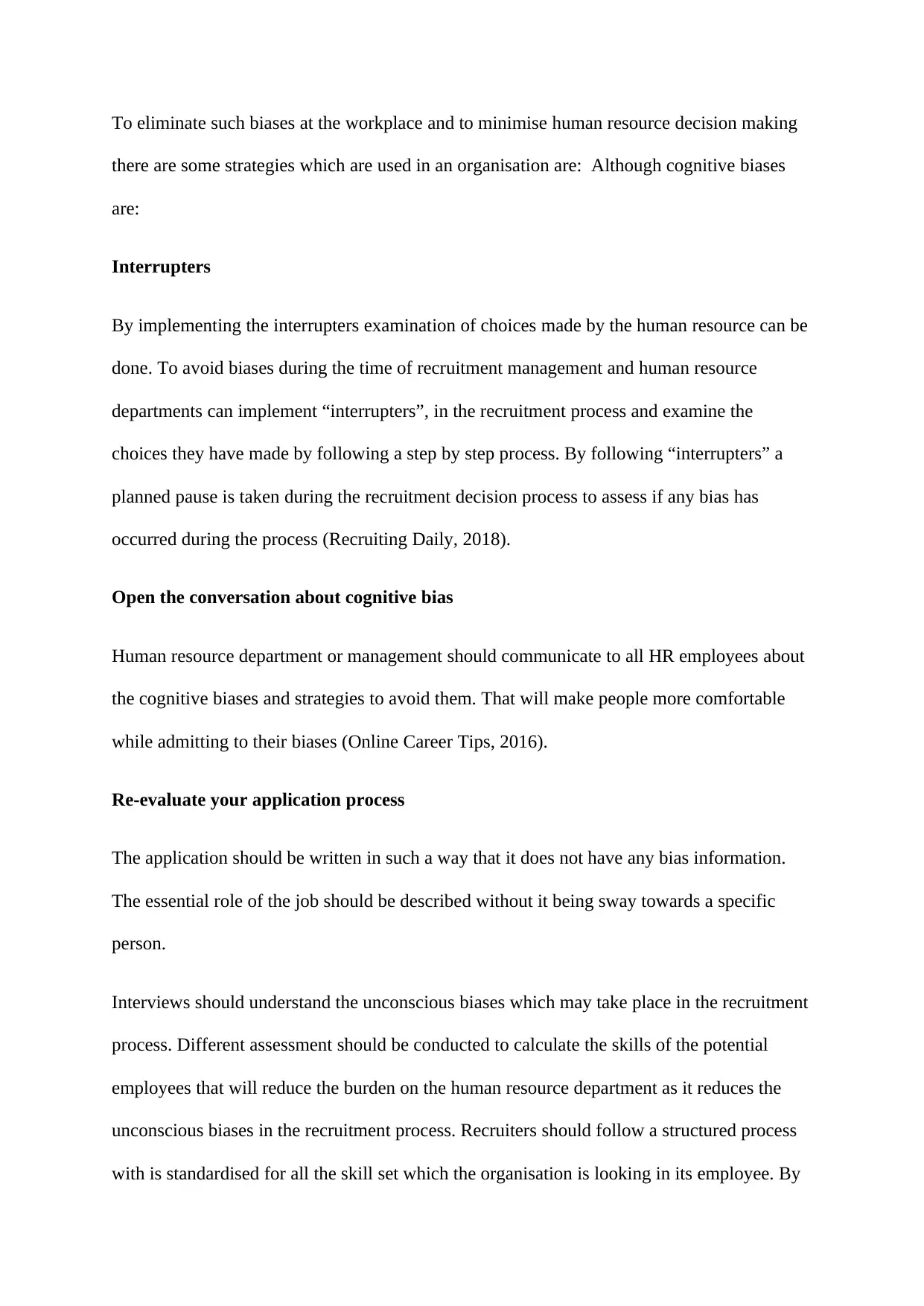
To eliminate such biases at the workplace and to minimise human resource decision making
there are some strategies which are used in an organisation are: Although cognitive biases
are:
Interrupters
By implementing the interrupters examination of choices made by the human resource can be
done. To avoid biases during the time of recruitment management and human resource
departments can implement “interrupters”, in the recruitment process and examine the
choices they have made by following a step by step process. By following “interrupters” a
planned pause is taken during the recruitment decision process to assess if any bias has
occurred during the process (Recruiting Daily, 2018).
Open the conversation about cognitive bias
Human resource department or management should communicate to all HR employees about
the cognitive biases and strategies to avoid them. That will make people more comfortable
while admitting to their biases (Online Career Tips, 2016).
Re-evaluate your application process
The application should be written in such a way that it does not have any bias information.
The essential role of the job should be described without it being sway towards a specific
person.
Interviews should understand the unconscious biases which may take place in the recruitment
process. Different assessment should be conducted to calculate the skills of the potential
employees that will reduce the burden on the human resource department as it reduces the
unconscious biases in the recruitment process. Recruiters should follow a structured process
with is standardised for all the skill set which the organisation is looking in its employee. By
there are some strategies which are used in an organisation are: Although cognitive biases
are:
Interrupters
By implementing the interrupters examination of choices made by the human resource can be
done. To avoid biases during the time of recruitment management and human resource
departments can implement “interrupters”, in the recruitment process and examine the
choices they have made by following a step by step process. By following “interrupters” a
planned pause is taken during the recruitment decision process to assess if any bias has
occurred during the process (Recruiting Daily, 2018).
Open the conversation about cognitive bias
Human resource department or management should communicate to all HR employees about
the cognitive biases and strategies to avoid them. That will make people more comfortable
while admitting to their biases (Online Career Tips, 2016).
Re-evaluate your application process
The application should be written in such a way that it does not have any bias information.
The essential role of the job should be described without it being sway towards a specific
person.
Interviews should understand the unconscious biases which may take place in the recruitment
process. Different assessment should be conducted to calculate the skills of the potential
employees that will reduce the burden on the human resource department as it reduces the
unconscious biases in the recruitment process. Recruiters should follow a structured process
with is standardised for all the skill set which the organisation is looking in its employee. By

using this structured process, recruits will gain the knowledge of the skill which people are
having and bring the recruitment process on track by avoiding biases in the recruitment
process. This process will benefit both the human resource recruitment process and potential
employee as the hiring process will remain same for all the applicants (Diversity Australia
(n.d.).
When the recruitment team gets the application from all the candidates, the demographic
information from all the application should be removed before accessing the information of
the applicants. Now the recruiters will only have the relevant qualifications, skills and
experience which will enhance the workforce diversity at the organisation. Further to avoid
any unconscious bias to take place in the recruitment process the final recruitment process
should be carried out by someone who is not involved at other stage of the hiring process
Summaries of the application should be given to final decision makers to check the
performance of potential employee at each stage (Geoffrey Beattie and Patrick Johnson,
2012).
Conclusion
To acquire the top talent in the competitive market is essential for company success.
Monitoring recruitment process and making it free from bias will enhance the hiring decision
and recruitment will be based on metrics decided by the organisation. That will enable human
resource department to recruit the right people for your organisation. Human Resource
Management recruitment bias deals in the hiring process of prospective employees.
Sometimes the bias is done without the knowledge of the person who is conducting an
interview or selection process. It is one of the significant factors for the growth of the
employee which should be monitored by different HR terminology used.
having and bring the recruitment process on track by avoiding biases in the recruitment
process. This process will benefit both the human resource recruitment process and potential
employee as the hiring process will remain same for all the applicants (Diversity Australia
(n.d.).
When the recruitment team gets the application from all the candidates, the demographic
information from all the application should be removed before accessing the information of
the applicants. Now the recruiters will only have the relevant qualifications, skills and
experience which will enhance the workforce diversity at the organisation. Further to avoid
any unconscious bias to take place in the recruitment process the final recruitment process
should be carried out by someone who is not involved at other stage of the hiring process
Summaries of the application should be given to final decision makers to check the
performance of potential employee at each stage (Geoffrey Beattie and Patrick Johnson,
2012).
Conclusion
To acquire the top talent in the competitive market is essential for company success.
Monitoring recruitment process and making it free from bias will enhance the hiring decision
and recruitment will be based on metrics decided by the organisation. That will enable human
resource department to recruit the right people for your organisation. Human Resource
Management recruitment bias deals in the hiring process of prospective employees.
Sometimes the bias is done without the knowledge of the person who is conducting an
interview or selection process. It is one of the significant factors for the growth of the
employee which should be monitored by different HR terminology used.
⊘ This is a preview!⊘
Do you want full access?
Subscribe today to unlock all pages.

Trusted by 1+ million students worldwide
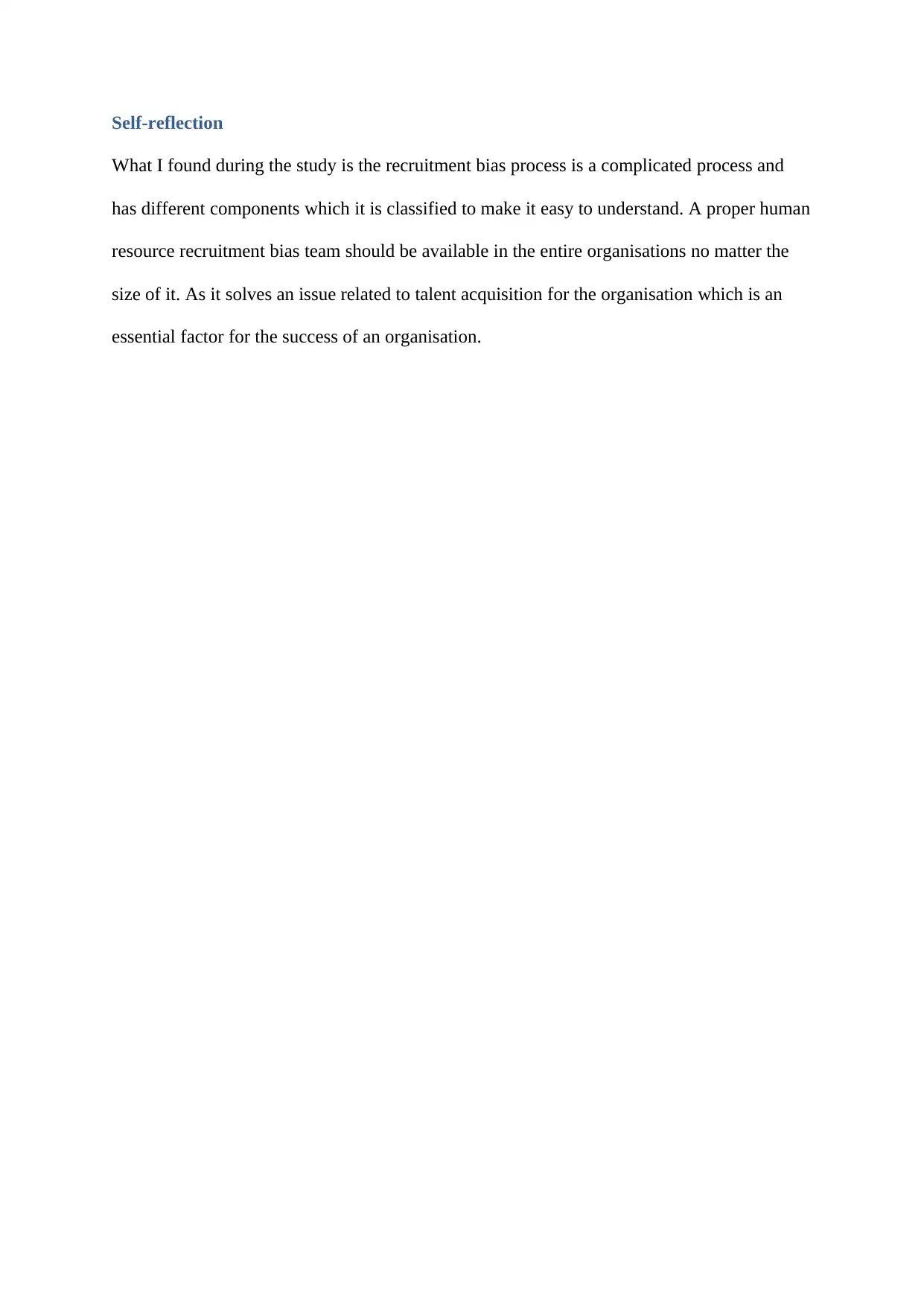
Self-reflection
What I found during the study is the recruitment bias process is a complicated process and
has different components which it is classified to make it easy to understand. A proper human
resource recruitment bias team should be available in the entire organisations no matter the
size of it. As it solves an issue related to talent acquisition for the organisation which is an
essential factor for the success of an organisation.
What I found during the study is the recruitment bias process is a complicated process and
has different components which it is classified to make it easy to understand. A proper human
resource recruitment bias team should be available in the entire organisations no matter the
size of it. As it solves an issue related to talent acquisition for the organisation which is an
essential factor for the success of an organisation.
Paraphrase This Document
Need a fresh take? Get an instant paraphrase of this document with our AI Paraphraser
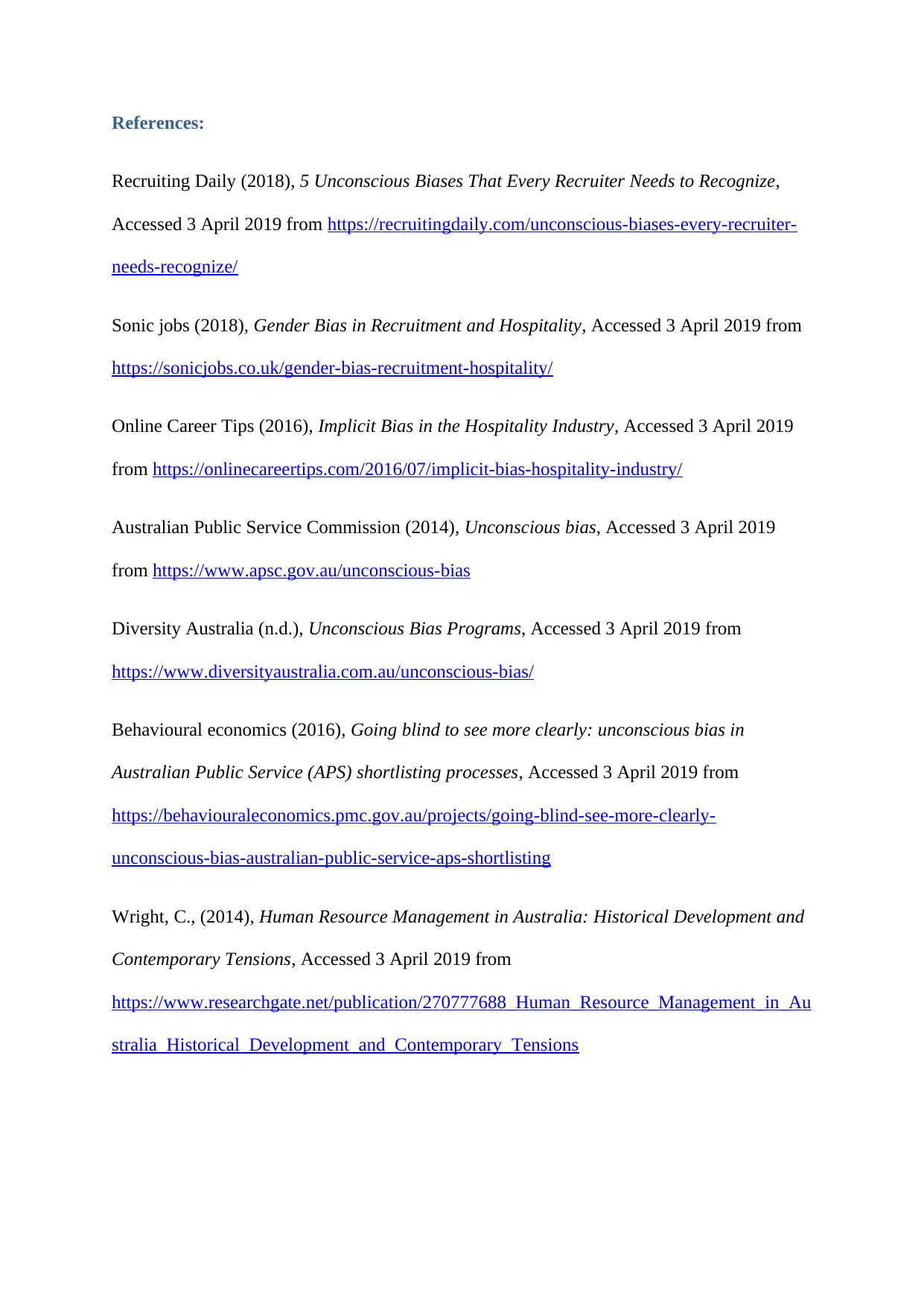
References:
Recruiting Daily (2018), 5 Unconscious Biases That Every Recruiter Needs to Recognize,
Accessed 3 April 2019 from https://recruitingdaily.com/unconscious-biases-every-recruiter-
needs-recognize/
Sonic jobs (2018), Gender Bias in Recruitment and Hospitality, Accessed 3 April 2019 from
https://sonicjobs.co.uk/gender-bias-recruitment-hospitality/
Online Career Tips (2016), Implicit Bias in the Hospitality Industry, Accessed 3 April 2019
from https://onlinecareertips.com/2016/07/implicit-bias-hospitality-industry/
Australian Public Service Commission (2014), Unconscious bias, Accessed 3 April 2019
from https://www.apsc.gov.au/unconscious-bias
Diversity Australia (n.d.), Unconscious Bias Programs, Accessed 3 April 2019 from
https://www.diversityaustralia.com.au/unconscious-bias/
Behavioural economics (2016), Going blind to see more clearly: unconscious bias in
Australian Public Service (APS) shortlisting processes, Accessed 3 April 2019 from
https://behaviouraleconomics.pmc.gov.au/projects/going-blind-see-more-clearly-
unconscious-bias-australian-public-service-aps-shortlisting
Wright, C., (2014), Human Resource Management in Australia: Historical Development and
Contemporary Tensions, Accessed 3 April 2019 from
https://www.researchgate.net/publication/270777688_Human_Resource_Management_in_Au
stralia_Historical_Development_and_Contemporary_Tensions
Recruiting Daily (2018), 5 Unconscious Biases That Every Recruiter Needs to Recognize,
Accessed 3 April 2019 from https://recruitingdaily.com/unconscious-biases-every-recruiter-
needs-recognize/
Sonic jobs (2018), Gender Bias in Recruitment and Hospitality, Accessed 3 April 2019 from
https://sonicjobs.co.uk/gender-bias-recruitment-hospitality/
Online Career Tips (2016), Implicit Bias in the Hospitality Industry, Accessed 3 April 2019
from https://onlinecareertips.com/2016/07/implicit-bias-hospitality-industry/
Australian Public Service Commission (2014), Unconscious bias, Accessed 3 April 2019
from https://www.apsc.gov.au/unconscious-bias
Diversity Australia (n.d.), Unconscious Bias Programs, Accessed 3 April 2019 from
https://www.diversityaustralia.com.au/unconscious-bias/
Behavioural economics (2016), Going blind to see more clearly: unconscious bias in
Australian Public Service (APS) shortlisting processes, Accessed 3 April 2019 from
https://behaviouraleconomics.pmc.gov.au/projects/going-blind-see-more-clearly-
unconscious-bias-australian-public-service-aps-shortlisting
Wright, C., (2014), Human Resource Management in Australia: Historical Development and
Contemporary Tensions, Accessed 3 April 2019 from
https://www.researchgate.net/publication/270777688_Human_Resource_Management_in_Au
stralia_Historical_Development_and_Contemporary_Tensions

Fan Y., Shepherd L.J., Slavich E, Waters D., Stone M., Abel R…..et al. (2019) Gender and
cultural bias in student evaluations: Why representation matters. PLoS ONE 14(2):
e0209749. Accessed 31 March 2019 from https://doi.org/10.1371/journal.pone.0209749
https://journals.plos.org/plosone/article?id=10.1371/journal.pone.0209749
Devine, P.G., Forscher, S.P., Austin, A.J., Cox, W.T.L., (2012) Long-term reduction in
implicit race bias: A prejudice habit-breaking intervention. Journal of Experimental Social
Psychology vol 48 pp 1267–1278. Amsterdam: Elsevier. Accessed 31 March 2019 from
http://www.sciencedirect.com/science/article/pii/S0022103112001369
Carnes, M., Devine, P.G., Isaac, C., Manwell, B.L., Ford, C.E., Winston, A.B……et al
(2012) Promoting Institutional Change Through Bias Literacy. Journal of Diversity in
Higher Education vol 5 pp 63-77. Accessed 31 March 2019 from
http://www.ncbi.nlm.nih.gov/pmc/articles/PMC3399596/
Geoffrey Beattie and Patrick Johnson (2012) Possible unconscious bias in recruitment and
promotion and the need to promote equality, Perspectives: Policy and Practice in Higher
Education, 16:1, 7-13, DOI: 10.1080/13603108.2011.611833
cultural bias in student evaluations: Why representation matters. PLoS ONE 14(2):
e0209749. Accessed 31 March 2019 from https://doi.org/10.1371/journal.pone.0209749
https://journals.plos.org/plosone/article?id=10.1371/journal.pone.0209749
Devine, P.G., Forscher, S.P., Austin, A.J., Cox, W.T.L., (2012) Long-term reduction in
implicit race bias: A prejudice habit-breaking intervention. Journal of Experimental Social
Psychology vol 48 pp 1267–1278. Amsterdam: Elsevier. Accessed 31 March 2019 from
http://www.sciencedirect.com/science/article/pii/S0022103112001369
Carnes, M., Devine, P.G., Isaac, C., Manwell, B.L., Ford, C.E., Winston, A.B……et al
(2012) Promoting Institutional Change Through Bias Literacy. Journal of Diversity in
Higher Education vol 5 pp 63-77. Accessed 31 March 2019 from
http://www.ncbi.nlm.nih.gov/pmc/articles/PMC3399596/
Geoffrey Beattie and Patrick Johnson (2012) Possible unconscious bias in recruitment and
promotion and the need to promote equality, Perspectives: Policy and Practice in Higher
Education, 16:1, 7-13, DOI: 10.1080/13603108.2011.611833
⊘ This is a preview!⊘
Do you want full access?
Subscribe today to unlock all pages.

Trusted by 1+ million students worldwide
1 out of 9
Related Documents
Your All-in-One AI-Powered Toolkit for Academic Success.
+13062052269
info@desklib.com
Available 24*7 on WhatsApp / Email
![[object Object]](/_next/static/media/star-bottom.7253800d.svg)
Unlock your academic potential
Copyright © 2020–2025 A2Z Services. All Rights Reserved. Developed and managed by ZUCOL.





